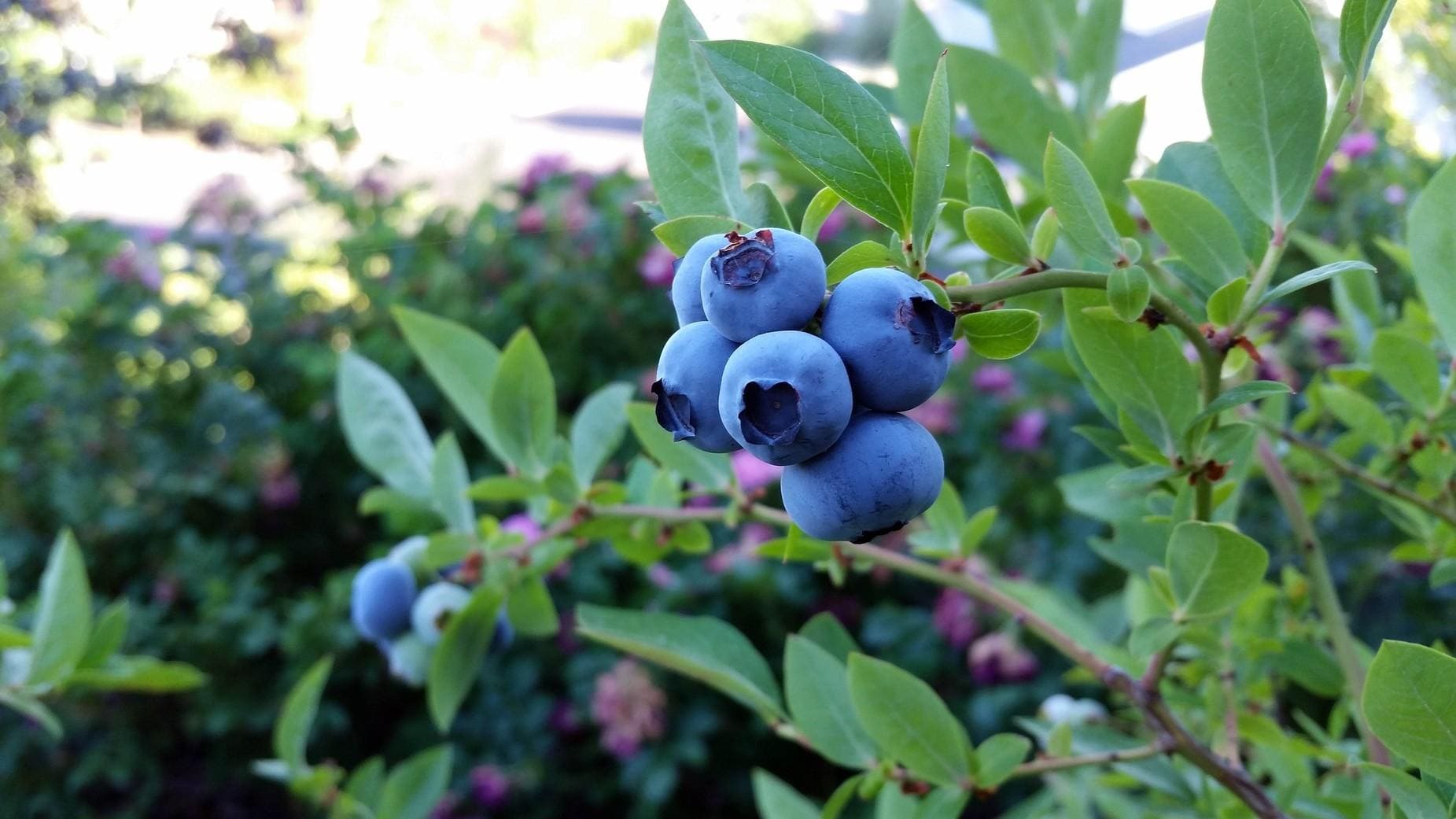Picture this: It’s a warm July morning, and you step into your backyard with a coffee mug in hand. As you walk past your thriving blueberry bushes, heavy with plump, sweet berries, you can’t help but smile.
You pluck a handful of sun-warmed fruit—each one bursting with flavor that puts store-bought berries to shame. This isn’t just a dream; it’s entirely achievable with the right knowledge and a bit of patience.
Growing your own blueberries is one of gardening’s most rewarding investments. These antioxidant-packed superfruits not only provide incredible health benefits but also transform your landscape with spring blooms, summer harvests, and stunning fall foliage.
While blueberries have specific requirements that might seem daunting at first, understanding their needs is the key to decades of delicious harvests.
Bottom Line Up Front: Success with blueberries hinges on three critical factors: acidic soil (pH 4.0-5.5), adequate winter chilling, and consistent moisture with excellent drainage. Master these fundamentals, and you’ll be rewarded with bushes that can produce fruit for 50+ years.
Understanding Blueberry Varieties: Matching Plants to Your Climate
Before you dig your first hole, it’s essential to select varieties suited to your climate and space. Think of blueberry types like different personalities—each has unique traits and environmental preferences that determine their success in your garden.
The Big Four Blueberry Types and Their Chilling Needs
Understanding chilling requirements is crucial for blueberry success. Chilling hours refer to the cumulative time temperatures stay between 32-45°F during winter dormancy. Without adequate chilling, flower buds won’t open properly, resulting in poor fruit set regardless of how well you care for your plants.
1. Northern Highbush Blueberries are the reliable workhorses, requiring 800-1,500 chilling hours and thriving in zones 4-7.
These 6-12 foot giants include dependable varieties like ‘Bluecrop’ (the most widely grown commercial variety), ‘Duke’ (early season with excellent cold tolerance), and ‘Chandler’ (famous for exceptionally large berries).

If you experience true winters with sustained cold temperatures, northern highbush varieties will be your most reliable choice.
2. Southern Highbush Blueberries are the heat-adapted hybrids, needing only 150-600 chilling hours and flourishing in zones 7-10.
Varieties like ‘O’Neal’ (considered to have the best flavor), ‘Misty’ (compact and productive), and ‘Legacy’ (producing up to double the yield of northern varieties) allow gardeners in warmer climates to enjoy homegrown blueberries. These 4-6 foot bushes often retain some leaves through mild winters.
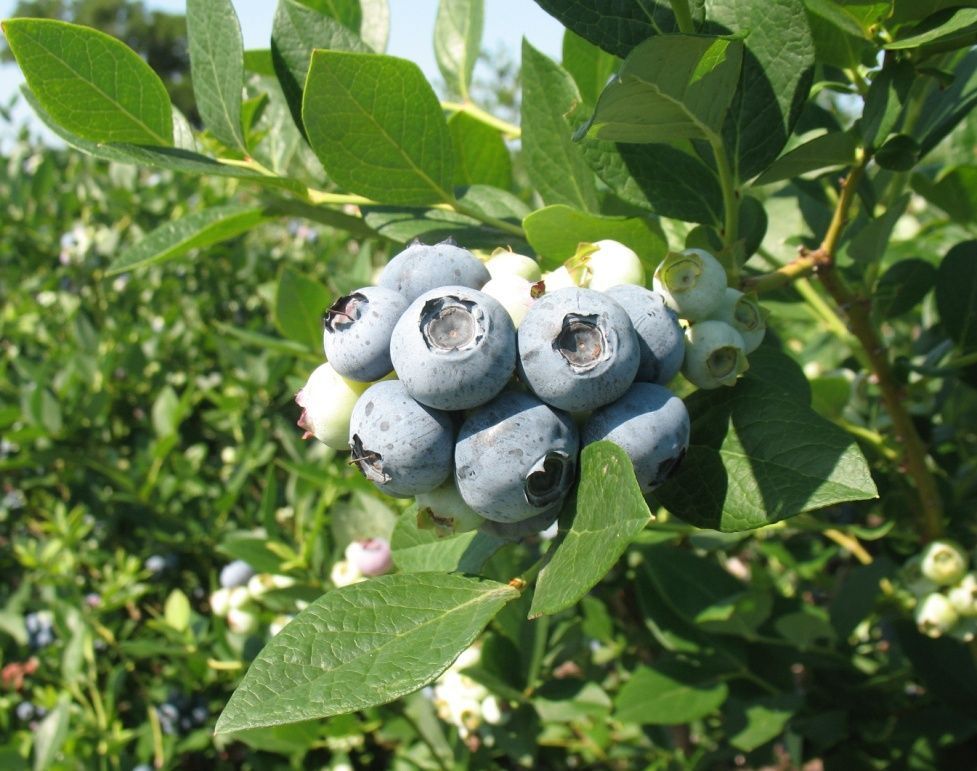
3. Lowbush Blueberries are the cold-climate champions requiring 1,000+ chilling hours and surviving in zones 3-7.
Staying under 2 feet tall, they spread via underground runners and produce the intensely flavored “wild” blueberries of Maine and eastern Canada. While more challenging to establish from nursery plants, they’re incredibly hardy once established.
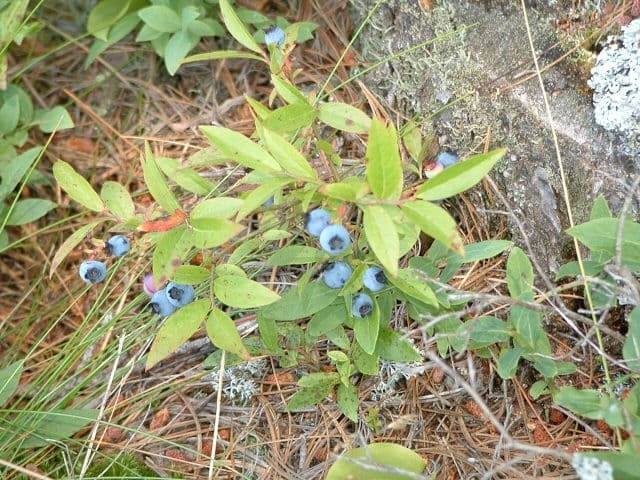
4. Rabbiteye Blueberries need 300-600 chilling hours and dominate southeastern gardens in zones 7-9.
These heat and drought-tolerant giants can reach 15 feet tall and include varieties like ‘Climax’ (early season), ‘Tifblue’ (late season standard), and ‘Pink Lemonade’ (unique pink berries with lemony flavor).
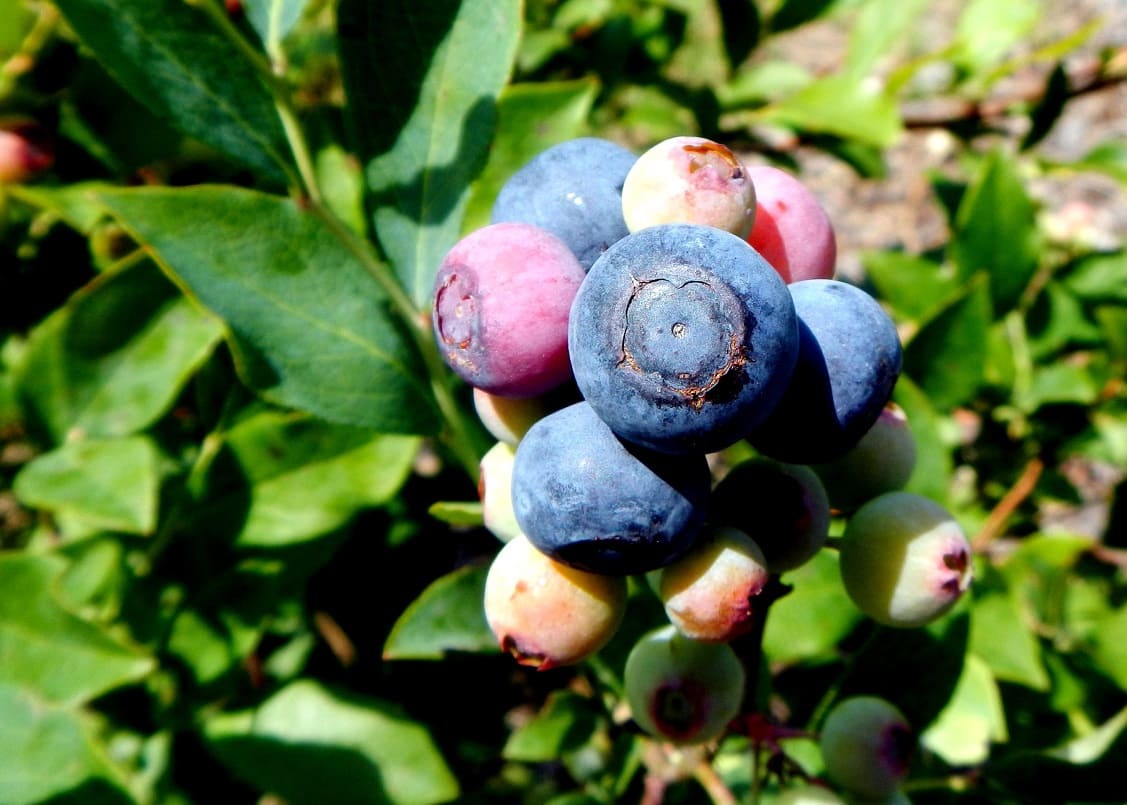
However, rabbiteye varieties absolutely require cross-pollination with other rabbiteye varieties—they won’t fruit well alone.
The Cross-Pollination Advantage
Here’s a secret that will dramatically improve your harvest: plant at least two different varieties that bloom simultaneously. While many blueberries are self-fertile, cross-pollination increases yields by 30-50% and produces larger, sweeter berries.
Even better, selecting early, mid-season, and late varieties extends your harvest from a few weeks to potentially three months.
The Non-Negotiables: Critical Success Factors
Soil Acidity: The Make-or-Break Factor
If blueberries were students, soil pH would be their most important subject—and they’re incredibly picky about getting an A+. These plants absolutely require acidic soil with a pH between 4.0-5.5, with 4.5 being optimal.
Why so specific? Blueberries evolved in acidic forest soils of North America and developed unique root systems that can only function in low-pH environments.
In neutral or alkaline conditions, they literally cannot absorb iron and other essential nutrients, leading to yellowing leaves (iron chlorosis), poor growth, and eventual death. This isn’t just a preference—it’s a biological requirement.
Testing your soil pH should be your first step, and it’s easier than you might think. Reliable digital pH meters cost $15-30 and provide instant results, while test strips offer a budget-friendly alternative.
Your local extension office often provides comprehensive soil testing for under $20, which includes pH plus nutrient levels and specific amendment recommendations.
If your soil tests above 5.5, you’ll need to acidify it, and this process takes time. Elemental sulfur is the gold standard—it works slowly but provides long-lasting results. Apply sulfur at least 3-6 months before planting, using roughly 1-2 pounds per 100 square feet to lower pH by one unit in average soils.
Sandy soils need less; clay soils need more. Iron sulfate works faster but requires about eight times the amount and frequent reapplication.
👉 Here’s How to Add Nitrogen to Soil: 18 Quick Fixes + Long-Term Solutions
Drainage: The Goldilocks Principle
Blueberries demand soil that’s consistently moist but never waterlogged—think of a wrung-out sponge as the ideal texture. Their shallow, fibrous root system can’t handle soggy conditions, which quickly lead to root rot, yet they also can’t tolerate drought stress.
Sandy loam soils naturally provide this balance, while heavy clay soils often require amendment or raised bed construction. A simple drainage test involves digging a hole 12 inches deep and filling it with water. If water remains after 24 hours, you need to improve drainage through raised beds, organic matter addition, or selecting a different location.
Sunlight: The Engine of Sweet Berries
Blueberries are sun worshippers, requiring 6-8 hours of direct sunlight daily for optimal fruit production. While they’ll survive in partial shade, expect significantly reduced yields and less flavorful berries. Morning sun is particularly important for drying dew and preventing disease issues.
Site Selection and Soil Preparation
Scouting the Perfect Location
Choose your blueberry site like you’re selecting prime real estate. The ideal location offers full sun exposure with some protection from harsh winds, good air circulation to prevent disease, and distance from large trees that compete for water and nutrients. Accessibility matters too—you’ll want easy access for maintenance and harvesting.
Avoid low-lying areas where cold air settles and water collects. A gentle slope provides excellent drainage while still retaining adequate moisture. If your yard lacks such a spot, don’t despair—raised beds can create the ideal microenvironment almost anywhere.
Building the Foundation: Soil Preparation
Soil preparation is like laying a foundation—do it right once, and it supports your plants for decades. This process should ideally begin 3-6 months before planting to allow amendments time to integrate and pH changes to stabilize.
Start by clearing the planting area of all grass, weeds, and debris. Work organic matter into the soil to improve both structure and acidity. Peat moss, aged pine bark, oak leaf mold, and composted pine needles all provide excellent organic matter while helping maintain acidic conditions.
Avoid mushroom compost, fresh manure, or regular garden compost, which can raise pH above acceptable levels.
For in-ground planting, create raised beds or mounded rows 6-12 inches high to ensure proper drainage. Mix native soil with organic amendments using roughly a 50-30-20 ratio: 50% existing soil, 30% acidic organic matter, and 20% drainage material like coarse sand if needed.
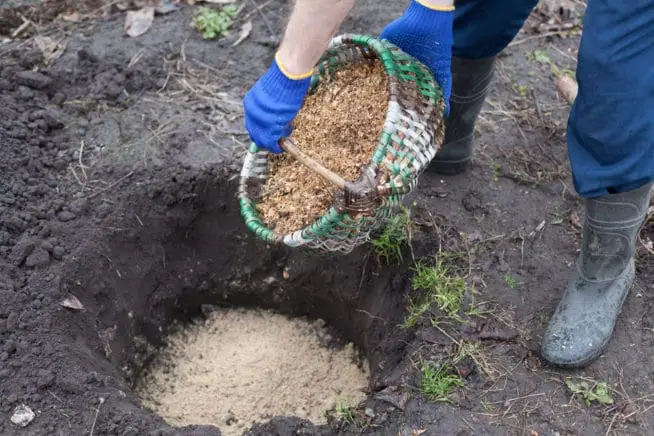
Planting Guide: Setting the Stage for Success
Timing Your Investment
The optimal planting window depends on your climate and plant type. In zones 6 and warmer, fall planting (October-November) allows root establishment during mild weather before summer heat arrives. In colder zones (3-5), early spring planting after the last hard frost but before bud break works best.
Container-grown plants offer more flexibility than bare-root plants, which must be planted during dormancy. If purchasing bare-root plants, plant them immediately upon arrival or store them in a cool, dark, moist location for no more than a few days.
Proper Plant Selection and Spacing
When purchasing blueberry plants, choose 2-3 year old specimens over older plants, which suffer more transplant shock, or younger plants, which take longer to establish. Look for plants with healthy root systems, multiple canes, and no signs of disease or pest damage.
Spacing varies by variety and intended use. For individual specimen plants, space northern highbush varieties 4-6 feet apart, southern highbush 3-4 feet apart, and rabbiteye varieties 5-6 feet apart. For hedgerows, reduce spacing to 3-4 feet for dense growth. Always allow 8-10 feet between rows for maintenance access.
The Planting Process: Getting It Right
Dig holes 2-3 times wider than the root ball but no deeper—planting too deep is one of the most common mistakes that leads to poor establishment or plant death. The crown of the plant should sit level with the surrounding soil surface.
If your plant is pot-bound with circling roots, gently tease them apart or make shallow vertical cuts through the root ball to encourage outward growth. Place the plant in the hole and backfill with your prepared soil mixture, firming gently to eliminate air pockets while avoiding compaction.
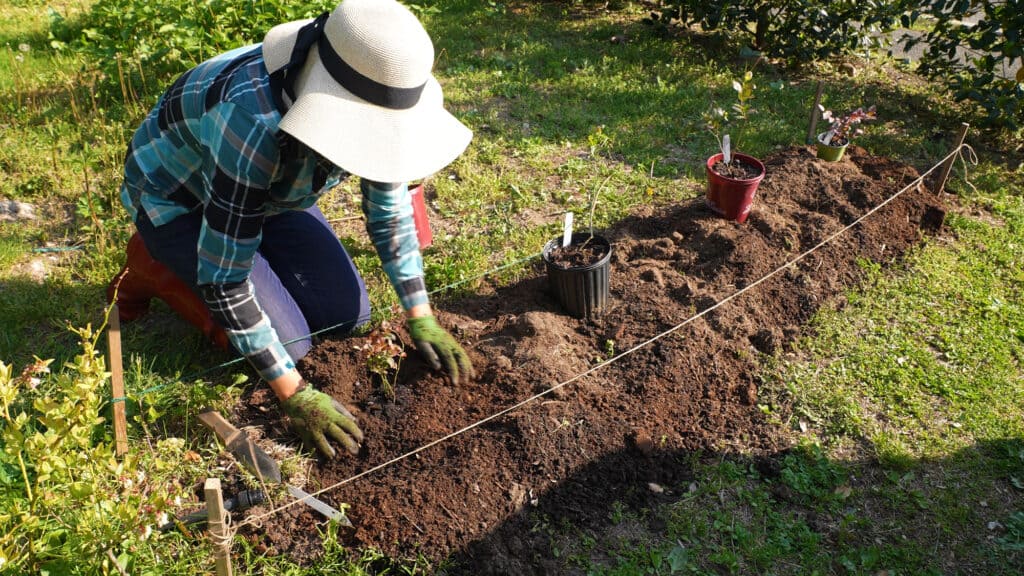
Water thoroughly immediately after planting, applying enough water to settle the soil completely around the roots. This initial watering is critical for eliminating air pockets and ensuring good root-to-soil contact.
Finish by applying a 3-4 inch layer of acidic organic mulch around each plant, keeping the mulch 2-3 inches away from the main stem to prevent rot issues. Pine bark, pine needles, oak leaves, or aged sawdust all make excellent choices.
Container Growing: Perfect Control in Any Environment
Growing blueberries in containers offers complete environmental control, making success possible even with challenging native soil conditions. Container growing also provides mobility—plants can be moved to optimize sun exposure or protected during severe weather.
Container Selection and Setup
Start with containers at least 18 inches in diameter and depth for young plants, eventually moving to 24-30 inch containers as plants mature. Ensure multiple drainage holes—inadequate drainage kills more container plants than any other factor. Avoid black containers in hot climates, as they absorb heat and stress root systems.
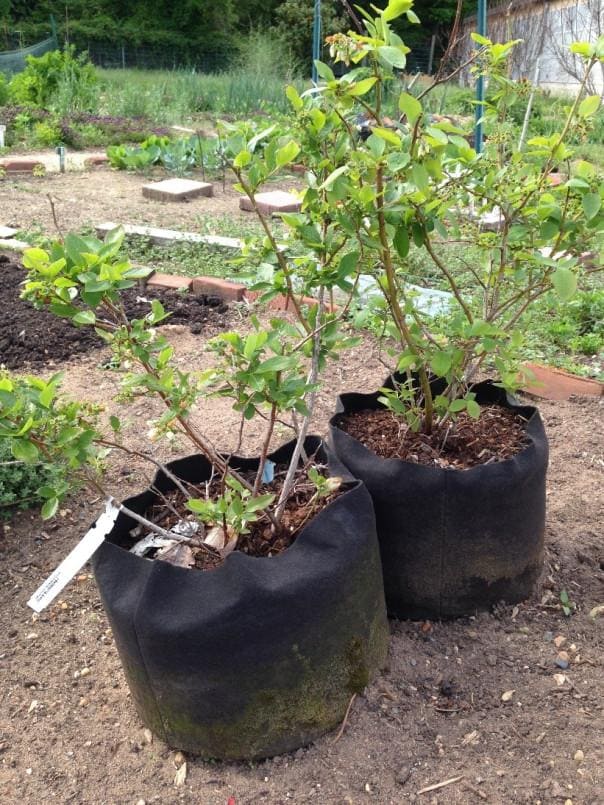
Create the perfect growing medium by mixing 50% peat moss, 30% quality potting soil, and 20% perlite or pine bark for drainage. This mixture should test between pH 4.0-5.0. Commercial potting mixes labeled for acid-loving plants often work well but should still be tested and adjusted if necessary.
👉 Here’s How to Grow Potatoes in Containers: Tips for a Bountiful Harvest
Container-Specific Care Requirements
Container plants have intensified care needs compared to in-ground plantings. Check soil moisture daily during hot weather—the soil should never completely dry out but shouldn’t remain soggy either. Water thoroughly until it drains from the bottom holes, then allow the top inch to dry before watering again.
Feed container plants monthly during the growing season (April through August) with liquid fertilizer formulated for acid-loving plants, diluted to half the recommended strength. Container plants exhaust soil nutrients more quickly than ground-planted specimens.
Winter protection becomes crucial in cold climates. Move containers to protected locations like unheated garages, wrap them in insulating materials, or group them together for mutual protection. The goal is preventing root zone freezing while maintaining dormancy requirements.
👉 Read the Delayed Planting Guide: Tips for Successful Container Tree Care
Essential Care Through the Seasons
Watering: Consistency Over Quantity
Blueberries appreciate consistent moisture more than occasional deep soaking. Provide 1-2 inches of water weekly, delivered slowly so it penetrates the root zone rather than running off. During fruit development, maintain especially consistent moisture to prevent berry splitting or dropping.
Drip irrigation systems work exceptionally well for blueberries, delivering water directly to the root zone while keeping foliage dry and reducing disease pressure. Position drip lines or soaker hoses under mulch for maximum efficiency and minimal evaporation.
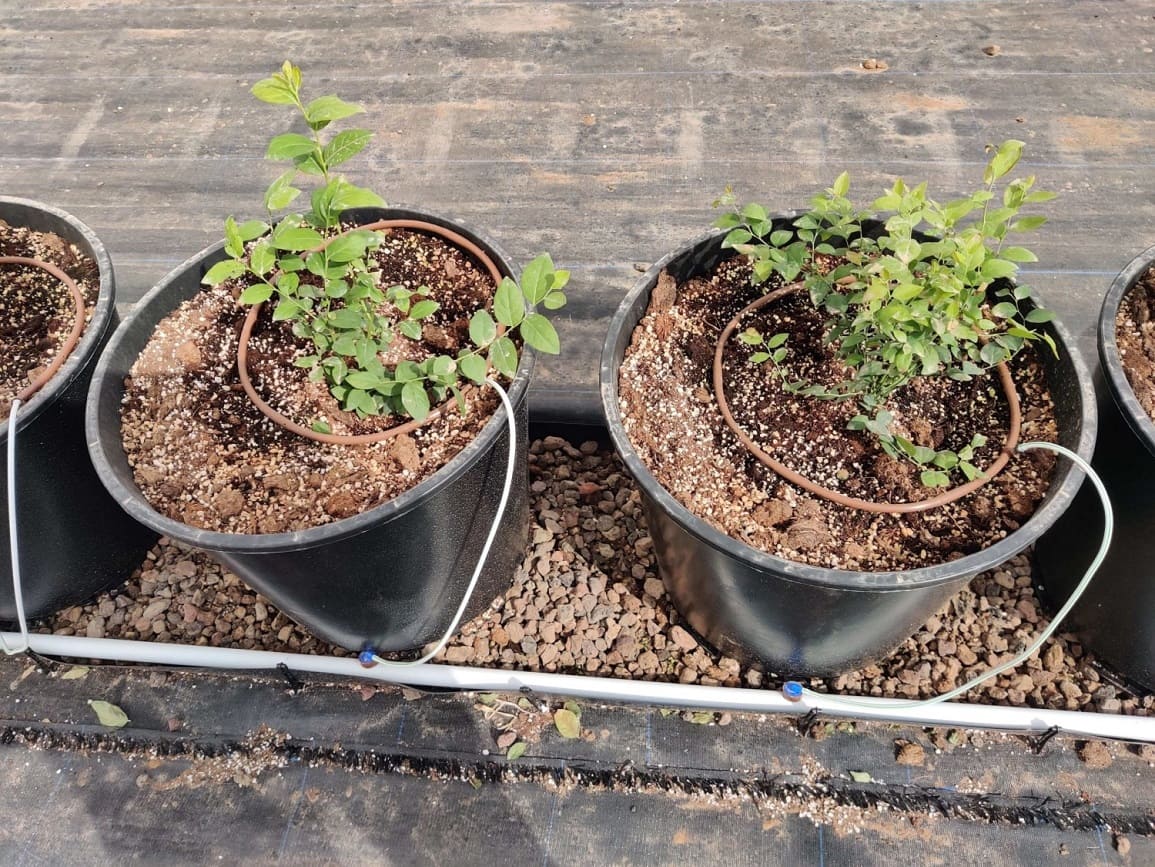
Rain water is ideal when available, as it’s naturally acidic and free of the salts and chemicals found in many municipal water supplies. If using tap water regularly, particularly in areas with hard water, consider periodic pH testing of your soil to ensure it remains in the optimal range.
Fertilizing: The Less-Is-More Approach
Blueberries are surprisingly sensitive to over-fertilization, particularly nitrogen excess, which can reduce fruit production and increase disease susceptibility. They also prefer ammonium-based nitrogen forms over nitrate-based forms, making fertilizers designed for acid-loving plants ideal.
For the first year after planting, skip fertilizing entirely—young plants need to focus energy on root establishment rather than top growth. Beginning in the second year, apply fertilizer when you see new spring growth beginning, typically March through April in most regions.
Use fertilizers specifically formulated for acid-loving plants like azaleas and rhododendrons, following package directions carefully. Apply a second feeding in late May if plants show signs of needing additional nutrients, but avoid fertilizing after mid-July to prevent late growth that won’t harden off before winter.
Organic options include cottonseed meal, blood meal, and fish emulsion, though liquid fertilizers should be diluted to half-strength to prevent burning. Well-aged compost can provide slow-release nutrients, but only use compost known to be acidic—test its pH before application.
Mulching: The Multi-Purpose Solution
A proper mulch layer serves multiple functions: moisture conservation, weed suppression, temperature moderation, and gradual soil acidification as organic mulches decompose. Apply 3-4 inches of organic mulch annually, refreshing as needed when it decomposes.
Pine bark, pine needles, oak leaves, and aged sawdust all make excellent choices. Avoid mulches that raise pH like mushroom compost or fresh grass clippings, which can also create anaerobic conditions if applied too thickly.
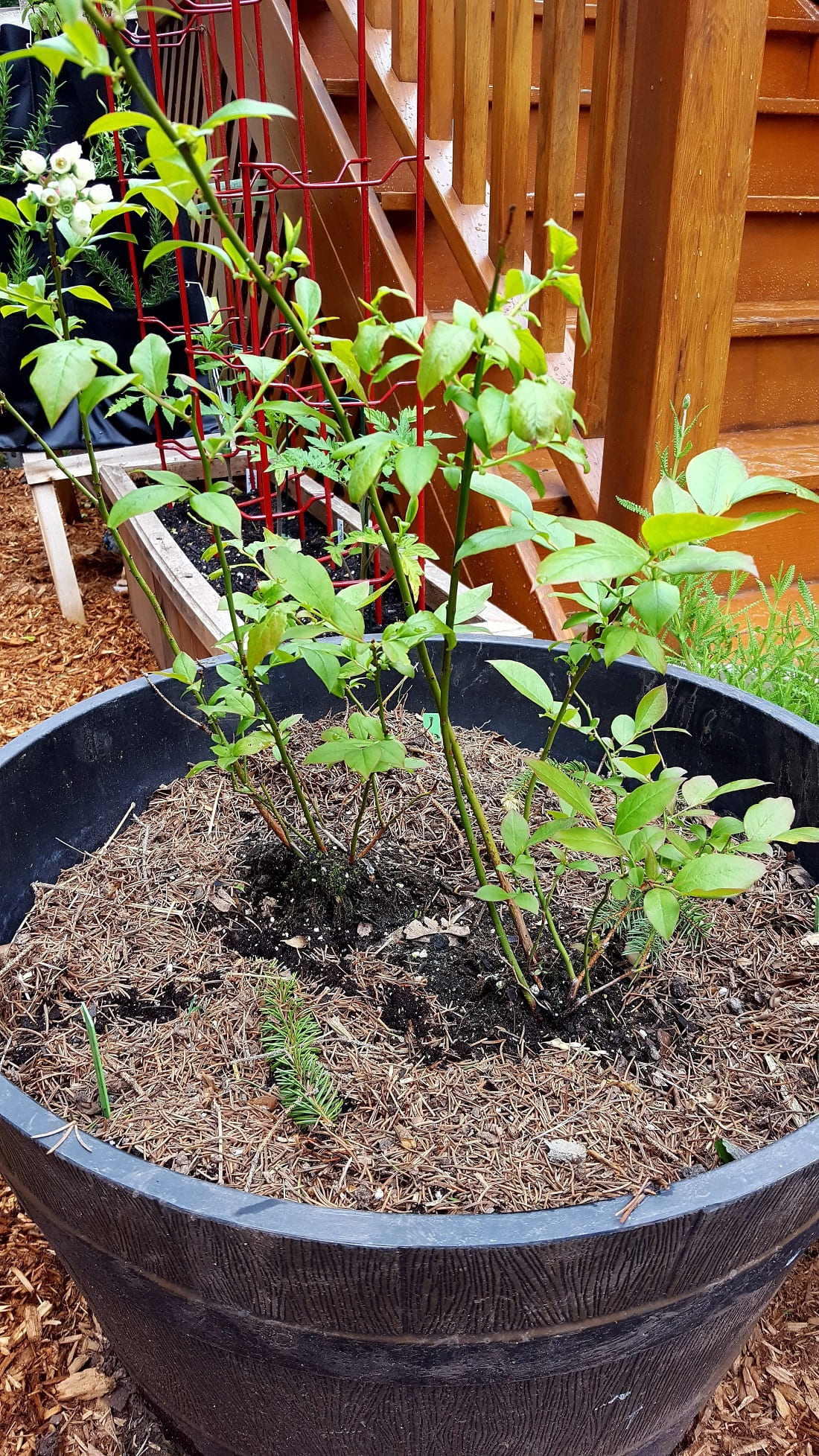
Keep mulch 2-3 inches away from plant stems to prevent moisture-related diseases and pest harborage. Extend mulch to the drip line of mature plants to cover the entire root zone.
Pruning for Health and Production
Understanding Blueberry Growth and Fruiting
Successful pruning requires understanding how blueberries grow and produce fruit. They fruit on one-year-old wood—last year’s growth—with the best fruit production on vigorous canes 6-12 inches long. Flower buds are fat and round, located at the tips of this wood, while vegetative buds are smaller and located lower on the branches.
As canes age beyond 6 years, they become less productive and more susceptible to disease. The goal of annual pruning is maintaining a balance of cane ages while ensuring adequate light penetration and air circulation throughout the plant.
Young Plant Pruning Strategy
For the first two years, focus on plant establishment over fruit production. Remove all flower buds the first year to direct energy into root and cane development—this short-term sacrifice pays long-term dividends. In the second year, you can leave a few flower clusters if the plant is vigorous, but continue prioritizing growth over production.
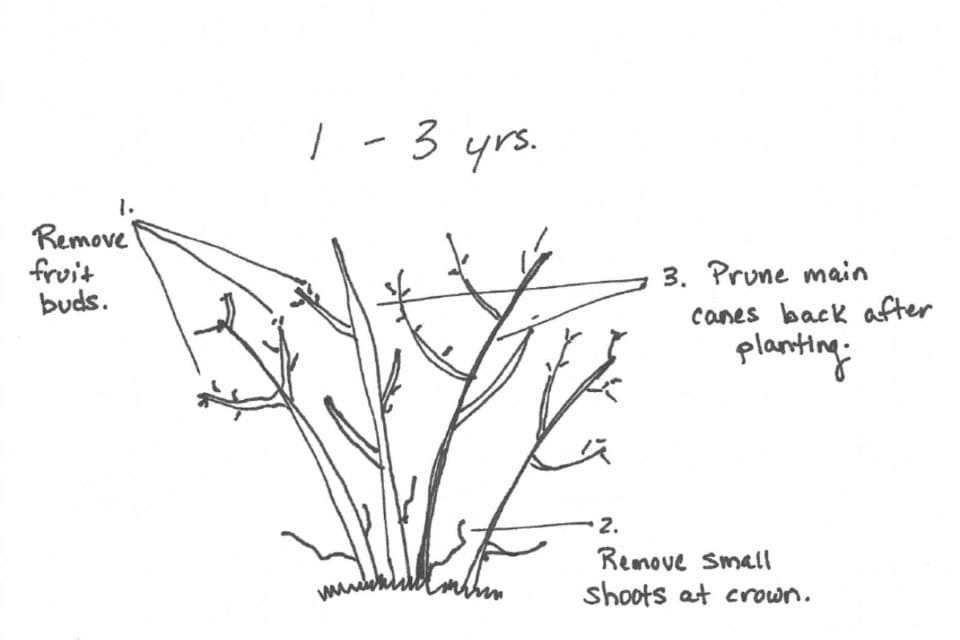
Shape young plants by removing low-growing branches that will touch the ground when laden with fruit, weak or damaged wood, and any canes growing toward the plant’s center. Establish the open vase shape that will serve the plant throughout its life.
Mature Plant Pruning Technique
Beginning in the fourth year, establish an annual winter pruning routine during dormancy, typically February through early March in most regions. Start with the four D’s: remove Dead, Diseased, Damaged, and Disoriented wood (branches growing toward the center or at odd angles).
Next, remove low-growing branches that will touch the ground and any weak, spindly growth that won’t support good fruit. Finally, remove the oldest canes (those over 6 years old) to make room for vigorous young growth from the base.
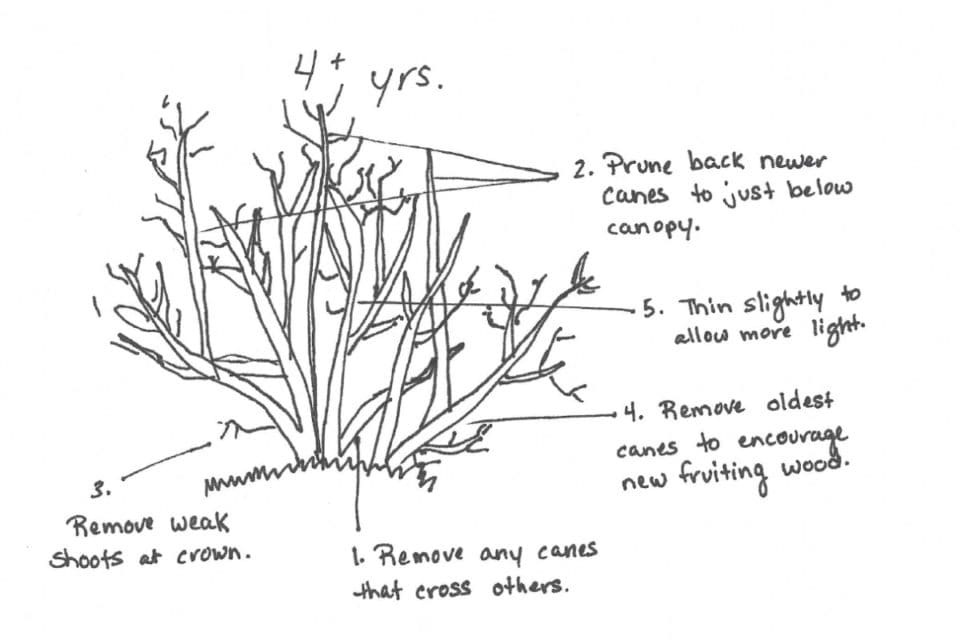
The mature plant should have 12-18 canes of varying ages, with roughly one-third young canes, one-third middle-aged productive canes, and one-third older canes being phased out. This system ensures continuous production while maintaining plant health.
👉 Here’s How to Prune Roses: A Simple Guide for Stunning Results
Pest and Disease Management
Major Pest Threats
While blueberries are generally pest-resistant, several insects can cause significant problems. Spotted wing drosophila has become the most serious pest in many regions, laying eggs in ripening fruit where larvae develop inside the berries. Fine exclusion netting applied before fruit begins coloring provides the best control.
Japanese beetles can skeletonize foliage during their summer flight period, particularly in eastern regions. Hand-picking small populations works for home gardens, while beneficial nematodes applied to soil in late spring can reduce larval populations.
Birds remain the biggest harvest threat for most growers. Protection strategies include bird netting (ensure it’s taut to prevent entanglement), reflective tape, noise makers, and encouraging predatory birds like hawks and owls. Plant alternative food sources like mulberries or serviceberries nearby to provide distraction crops.
Scale insects occasionally infest blueberry plants, appearing as small bumps on branches and causing decline over time. Horticultural oil applications during dormancy effectively control most scale species.
Disease Prevention and Management
Most blueberry diseases result from environmental stress or poor growing conditions rather than aggressive pathogens. Proper site selection, adequate spacing, annual pruning, and avoiding overhead irrigation prevent most problems.
Mummy berry is perhaps the most serious fungal disease, causing berries to shrivel and mummify on the bush. Remove and destroy all mummified berries during dormant season pruning, and ensure good air circulation through proper spacing and pruning.
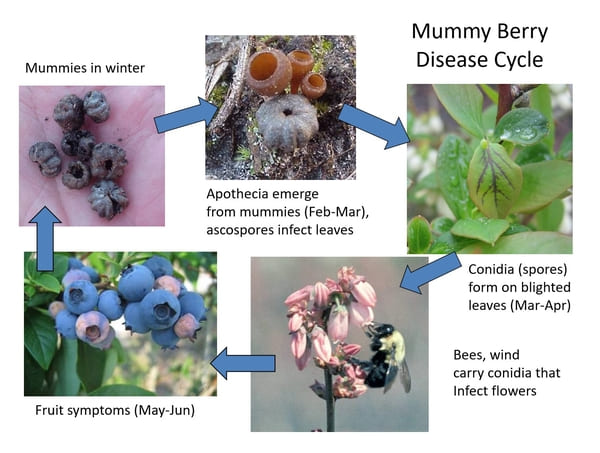
Root rot occurs in poorly drained soils and is largely preventable through proper site selection and soil preparation. Once established, root rot is difficult to cure, making prevention critical.

Bacterial canker can affect new growth, appearing as reddish to black areas on young wood. Remove affected wood during pruning and avoid wounding plants during the growing season.
Propagation: Growing Your Own Plants
Softwood Cutting Propagation
Growing new plants from cuttings allows you to expand your blueberry patch economically while preserving the exact characteristics of parent plants. Take softwood cuttings in early summer when new growth is partially hardened but still flexible.
Cut 4-6 inch pieces from healthy, disease-free plants, making cuts just above leaf nodes. Remove lower leaves and dip cut ends in rooting hormone before inserting into a 50-50 mix of peat moss and perlite. Keep cuttings in bright, indirect light with consistent moisture and temperatures around 70°F.
Rooting typically takes 6-8 weeks, after which cuttings can be gradually acclimated to outdoor conditions and transplanted the following spring. Success rates vary by variety, but most gardeners can expect 50-70% success with proper technique.
👉 Here’s How to Propagate Plants in Water: Easy Step-by-Step Method
Hardwood Cutting Method
Hardwood cuttings taken during dormancy offer another propagation option, though success rates are generally lower. Take 6-inch cuttings from pencil-thick wood in late winter, bundle them in slightly moist peat moss, and store in the refrigerator for 6-8 weeks before planting.
Plant treated cuttings in the propagation medium and maintain as with softwood cuttings. Hardwood cuttings take longer to root—often 3-4 months—but can be very rewarding when successful.
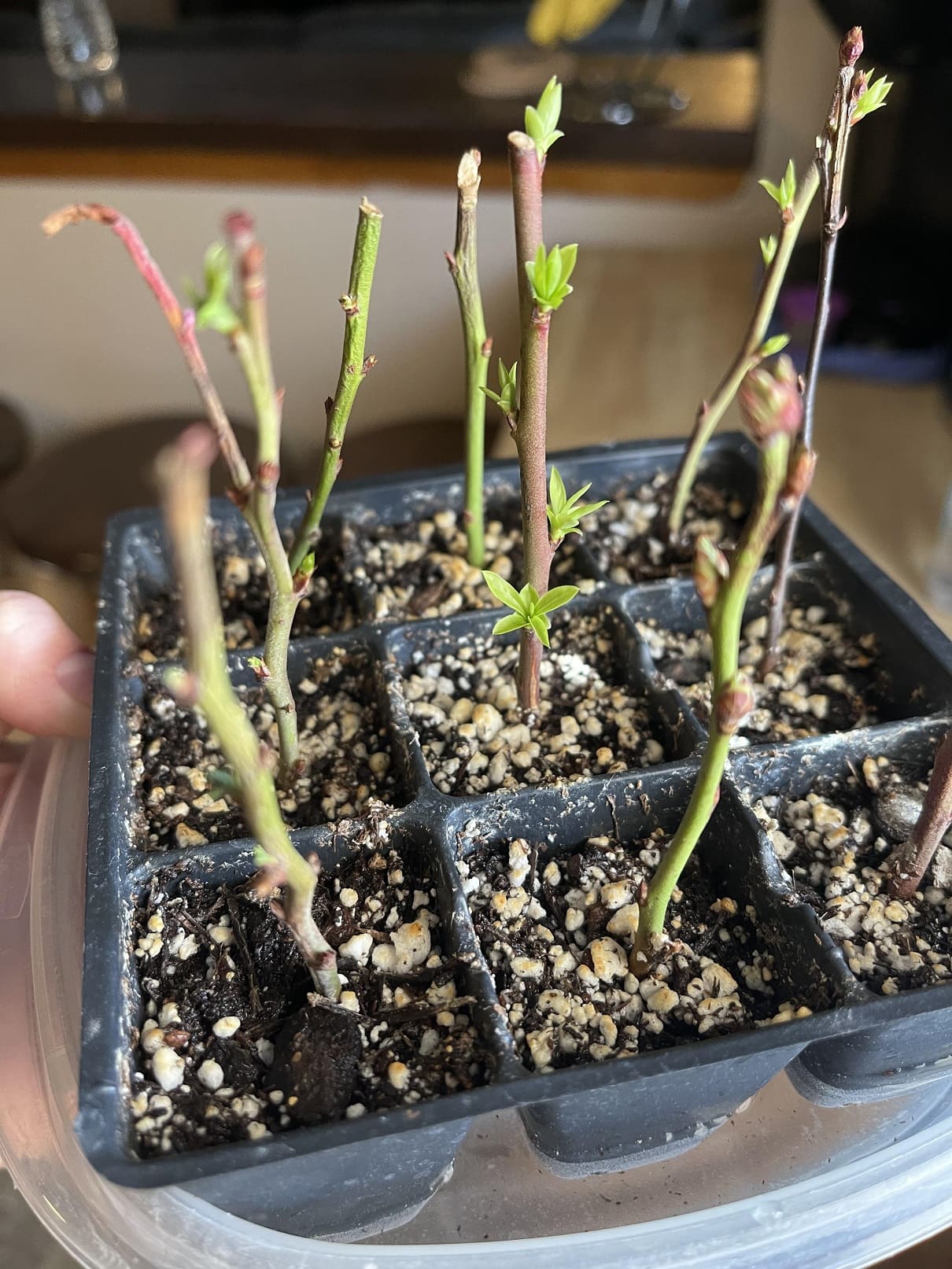
Harvesting: Reaping Your Rewards
Recognizing True Ripeness
The biggest harvesting mistake is picking berries too early simply because they’ve turned blue. True ripeness occurs 3-7 days after color change, when berries develop their full sugar content and complex flavor profile. Ripe berries will separate easily from the stem with gentle handling and have a slight bloom on their surface.
Taste-test berries from different parts of the bush, as sun exposure affects ripening rates. When berries are consistently sweet with balanced acidity, begin your harvest. Early morning picking when berries are cool and firm yields the best quality fruit.
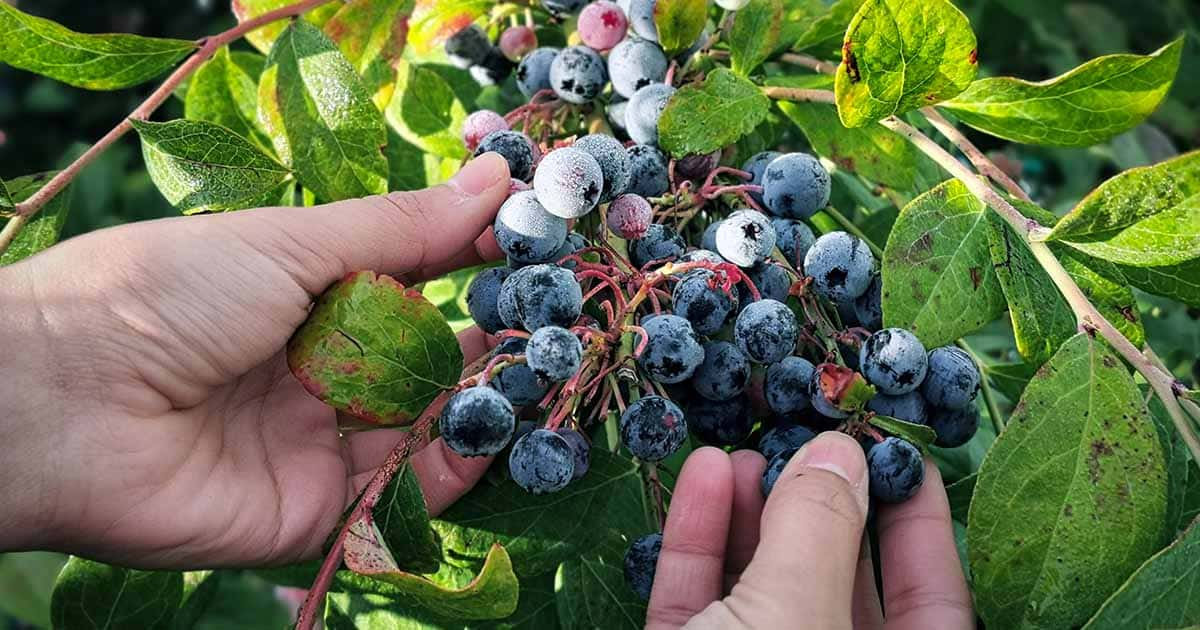
Harvest Techniques and Timing
Pick berries individually by gently rolling them between your fingers—ripe fruit will practically fall off the stem. Harvest every 3-5 days during peak season, as berries continue ripening over several weeks on each bush.
Use shallow containers to prevent crushing lower berries under the weight of those above. Avoid washing berries until just before use, as moisture accelerates spoilage. Properly handled berries can maintain quality for 7-10 days under refrigeration.
👉 Discover When and How to Harvest Vegetables for Peak Flavor: Timing and Tips for Every Crop
Yield Expectations and Planning
Understanding realistic yield expectations helps with planning and prevents disappointment. Young plants (years 2-3) typically produce 1-2 pounds of berries annually. Production increases steadily, reaching 8-15 pounds per mature bush by year 7-8. Exceptional care and optimal conditions can produce even higher yields.
Plan on harvesting for 4-6 weeks per variety, with early, mid-season, and late cultivars extending total harvest season to 10-12 weeks. This extended season makes the investment in multiple varieties particularly worthwhile.
Seasonal Care Calendar
Spring Tasks (March-May)
Spring marks the beginning of the active growing season. Apply annual fertilizer when buds begin swelling but before they open fully. Refresh mulch layers that have decomposed over winter, and begin regular watering if rainfall is insufficient.
Complete dormant season pruning before buds break—once growth begins, pruning wounds heal more slowly and can stress plants. Remove winter protection materials gradually as temperatures moderate.
Summer Care (June-August)
Summer focus shifts to consistent watering, pest monitoring, and harvest management. Maintain consistent soil moisture throughout fruit development, increasing watering frequency during hot, dry periods.
Monitor for pest activity, particularly spotted wing drosophila as berries begin ripening. Apply bird protection before the first berries begin changing color—waiting until berries are ripe is too late.
Fall Preparation (September-November)
As harvest concludes and plants prepare for dormancy, gradually reduce watering frequency while ensuring plants don’t become completely dry. Allow natural leaf drop to occur—avoid removing healthy leaves, as they’re storing energy for next year’s growth.
In colder regions, apply winter protection around Thanksgiving or when temperatures consistently drop below freezing. Mulch can be mounded slightly higher around plant bases for additional root protection.
Winter Maintenance (December-February)
Winter is the optimal time for major maintenance tasks. Complete annual pruning during the dormant season, removing old, weak, and diseased wood. This is also an excellent time for soil testing and amendment planning for the coming year.
Review the past season’s performance and plan any additions or changes for the upcoming year. Order new varieties for spring planting, and research solutions for any problems encountered during the growing season.
Frequently Asked Questions
- Q: How long before my blueberry plants produce a meaningful harvest?
Expect small harvests in years 2-3 (1-2 pounds per bush) with production steadily increasing to 8-15 pounds per mature bush by years 6-8. The wait is worth it—mature bushes can produce for 50+ years with proper care.
- Q: Can I grow blueberries if my soil is naturally alkaline?
Absolutely! Container growing or raised beds filled with acidic soil mix work beautifully in alkaline soil areas. Many successful growers use this approach rather than fighting their native soil. The key is creating the right environment within your control.
- Q: My blueberry leaves are turning yellow with green veins. What’s wrong?
This classic symptom indicates iron chlorosis, usually caused by soil pH that’s too high. Test your soil pH and acidify if needed. This is often the first sign that soil amendments are wearing off and need refreshing.
- Q: Do I really need multiple varieties for good fruit production?
While not absolutely necessary for self-fertile varieties, planting 2-3 different cultivars typically increases yields by 30-50% and provides a longer harvest season. Even self-fertile varieties benefit significantly from cross-pollination.
- Q: How do I protect my berries from birds without harming wildlife?
Bird netting remains the most effective protection when properly installed. Ensure netting is taut and securely fastened to prevent bird entanglement. Alternative strategies include reflective tape, noise makers, and planting alternative food sources nearby as distraction crops.
- Q: Can I grow blueberries organically?
Definitely! Blueberries are naturally pest-resistant and respond excellently to organic methods. Focus on soil health through organic amendments, use beneficial insects for pest control, and choose disease-resistant varieties. Most successful blueberry growers use minimal or no pesticides.
Your Path to Blueberry Success
Growing blueberries successfully isn’t about having a green thumb—it’s about understanding and meeting their specific environmental needs. While they’re particular about soil pH and consistent moisture, once you establish the right conditions, they become remarkably low-maintenance plants that reward you for decades.
The journey requires patience, especially during the first few years as plants establish and mature. But this patience pays extraordinary dividends when mature bushes provide pounds of premium berries that far surpass anything available in stores.
Beyond the fruit, you’ll gain the satisfaction of nurturing these beautiful plants through their seasonal cycles and creating habitat that supports pollinators and beneficial insects.
Start small with 2-3 varieties suited to your climate, focus on creating optimal growing conditions, and learn your plants’ rhythms through their first few seasons. As your experience grows, you can expand your collection and experiment with different varieties and techniques.
Remember that every expert blueberry grower started exactly where you are now—with enthusiasm, basic knowledge, and a willingness to learn from both successes and setbacks. Your future self will thank you for taking the first step toward homegrown blueberry abundance.
Ready to begin your blueberry adventure? Start by testing your soil pH and researching varieties adapted to your climate zone. Whether you choose in-ground or container growing, focus on meeting their fundamental needs from day one.
With proper preparation and consistent care, you’ll soon join the ranks of gardeners who can’t imagine summer without handfuls of sweet, sun-warmed blueberries fresh from their own bushes.
